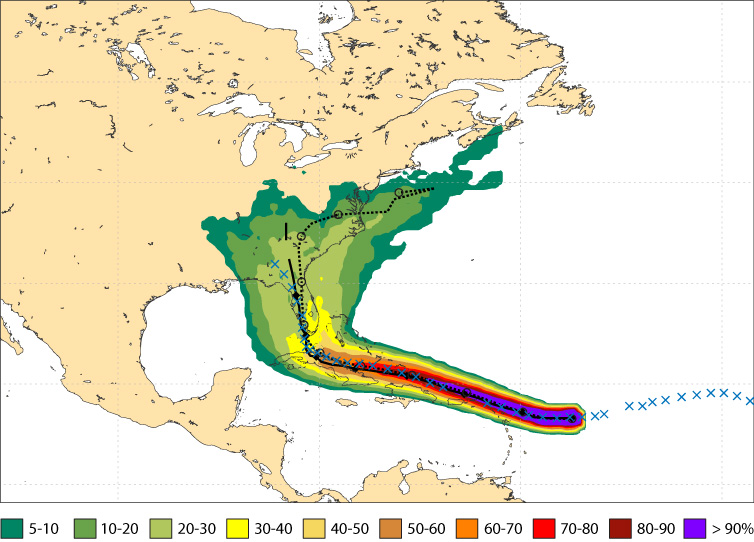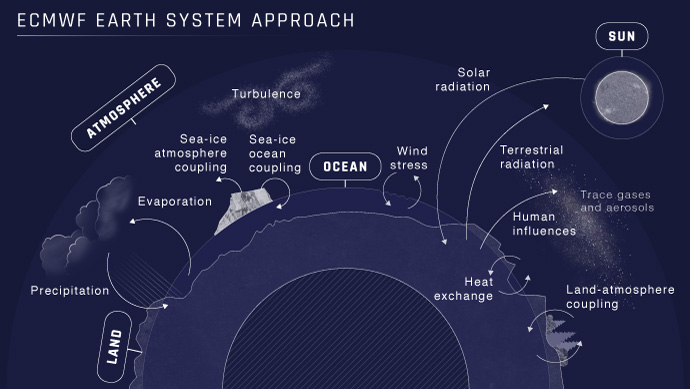

ECMWF runs one of the most powerful supercomputers in Europe and hosts the world’s largest meteorological archive. (Photo: A. Brookes/ECMWF Copernicus)
ECMWF was created over four decades ago with the goal of improving global numerical weather predictions to best support its Member and Co-operating States, as well as the broader weather and climate communities. The challenge was met, and ECMWF now provides its users around the world with predictions ranging from 10 days to a year ahead at a level of accuracy and reliability second to none. Since its creation, the Centre has owed this leading position to a combination of collaborative principles, top-level scientists and powerful HPC capacities.
In weather prediction, supercomputers are far more than a means to an end. Of course, they allow the Centre to process tens of millions of observations every day, and operate the calculations that underpin the millions of lines of codes that make our numerical model in an extremely tight timeframe. Today computing at ECMWF also has a more strategic position, as it has become clear that progress in numerical weather prediction (NWP) is intimately connected with progress in supercomputing. Over the years, more computing power has enabled us to increase the skill and detail of our forecasts. This has brought huge value to society, not least through early warnings of severe weather. But as the forecasting system becomes more complex, with current computing architectures it will soon be impossible to issue forecasts within schedule and at a reasonable cost.
A new generation of computing systems with exascale capabilities promise much greater energy efficiency – but they will rely on parallel processing at levels to which current NWP codes are not adapted. Changes are needed throughout the entire NWP processing chain if we are to exploit these new opportunities for energy efficiency. And those changes need to be developed in sync with developments currently taking place in computing. Weather and computing sciences must walk hand in hand if we want to continue to advance weather science, as outlined in our recent article about Shaping the future of supercomputing in numerical weather prediction.
The opportunity has now arisen for a new Director of Computing to lead ECMWF’s computing efforts.
The scientific challenges are not the only aspect of this leadership role. The Centre runs one of the most powerful supercomputers in Europe and hosts the world’s largest meteorological archive. To meet the required flexibility for future growth, ECMWF’s data centre is being relocated to Bologna, Italy, and will be operational in 2020. The new Director of Computing will be responsible for delivering this challenging transition, fit-out and migration, whilst ensuring that ECMWF’s computing capability continues to support some of the most critical scientific advances of our time.

The site of ECMWF’s new data centre in Bologna, Italy. The facility will become operational in 2020 and will house the Centre’s next high-performance computer facility, the tender for which will be issued in Q3 2018. (Image: gmp von Gerkan, Marg & Partner)
Weather prediction’s role is to protect lives and property
The weather services of ECMWF Member States receive ECMWF's numerical weather prediction data in real time, 24 hours a day, 7 days a week. Early indications of the risk of severe weather are particularly important, as illustrated by the dangerous windstorms that hit Europe in October 2017. On the night of 28 October 2017, cyclone Herwart brought very strong winds, most notably over Germany, the Czech Republic and Poland. There were at least four fatalities, damage to trees and buildings and disruption to infrastructure. Throughout the lead-up to this event, ECMWF ensemble forecasts provided a consistent signal for a dangerous windstorm, which grew stronger with time.

Ensemble-based forecasts for day 5 of Extreme Forecast Index (EFI, shaded) and Shift of Tails (SOT, black contours) for maximum wind gust during 29 October 2017, highlighting a much elevated risk of a severe wind event over a large area.
Each ECMWF forecast is made of 52 members – separate forecasts made by the same computer model, all activated from the same starting time with slightly different starting conditions. An ensemble of forecasts produces a range of possible scenarios rather than a single predicted value. The distribution of the ensemble members gives an indication of the likelihood of occurrence of those scenarios. Increasingly, ensembles are routinely used to provide forecasters and users with the range of weather scenarios that could happen in the future.
An example is the ensemble-based strike probability for Hurricane Irma, issued by ECMWF on 5 September 2017.

The chart shows the ECMWF ensemble-based probability that Hurricane Irma would pass within a 120 km radius during the next 10 days, according to the forecast issued at 00 UTC on 5 September 2017. Both ECMWF’s high-resolution forecast (solid line) and the ensemble mean (dotted line) turned out to be very close to the track as subsequently observed (crosses). However, the ensemble as a whole gave vital information on the range of possible tracks, something which a single forecast cannot provide.

ECMWF's Earth system approach, part of the ten-year Strategy published in 2016, sees Earth system modelling and assimilation as the way to improve further skill in the forecast ranges covered by ECMWF.
ECMWF’s Strategy to 2025 includes the key goals of delivering skilful ensemble predictions of high-impact weather up to two weeks ahead and predicting large-scale patterns and regime transitions up to four weeks ahead. Achieving these goals will require not only an improved model of the atmosphere, but also increased emphasis on additional components of the Earth system including the ocean, waves, sea-ice, land surface, aerosols and all their interactions.

The value and importance of accurate and reliable weather predictions is apparent in most aspects of our daily lives. From energy and agriculture planning to protecting lives and property, continuing to improve weather forecasts remains a critical challenge at the heart of the existence of ECMWF. It is a task which requires atmospheric and computing sciences to work hand in hand, and be led by visionary men and women.
